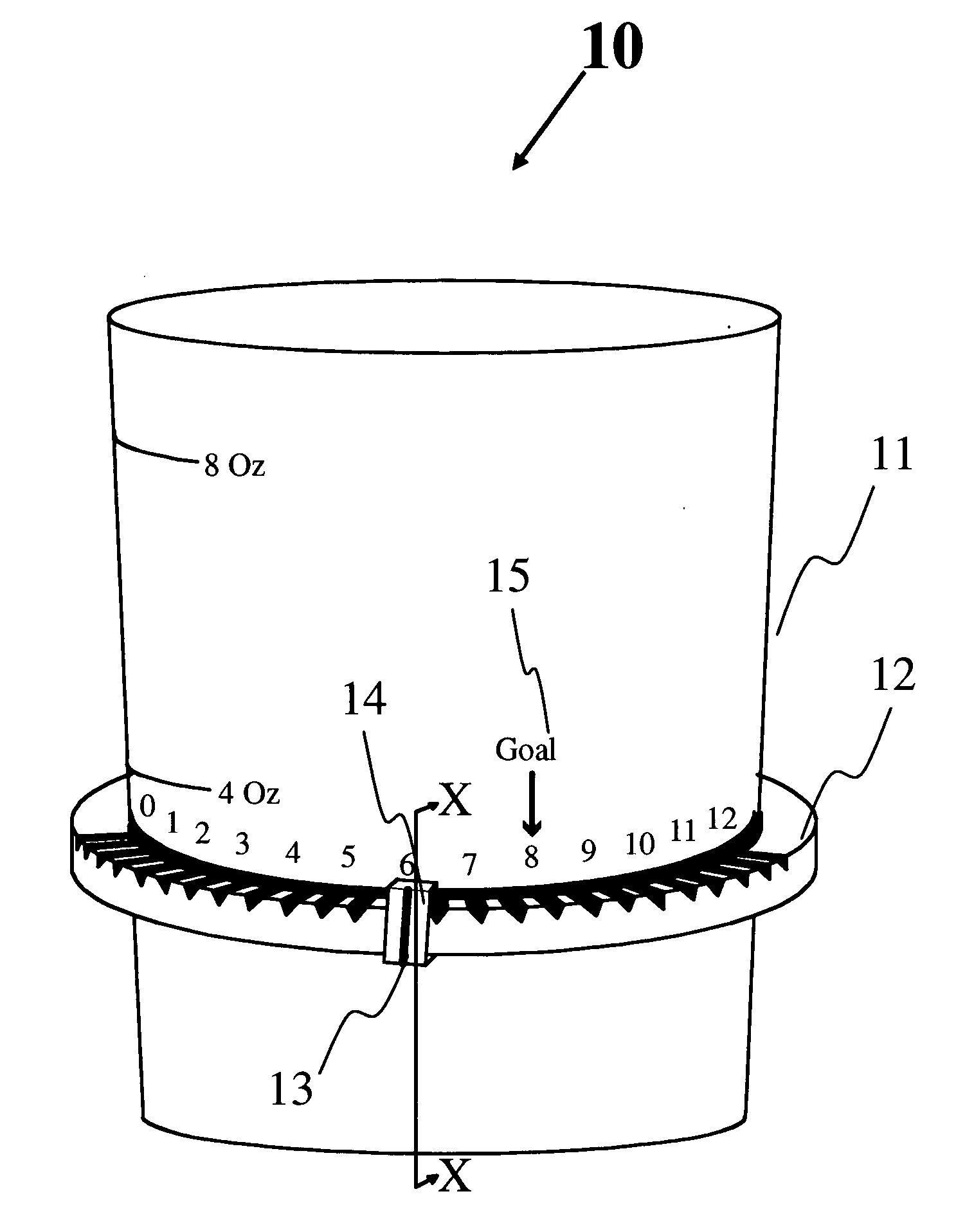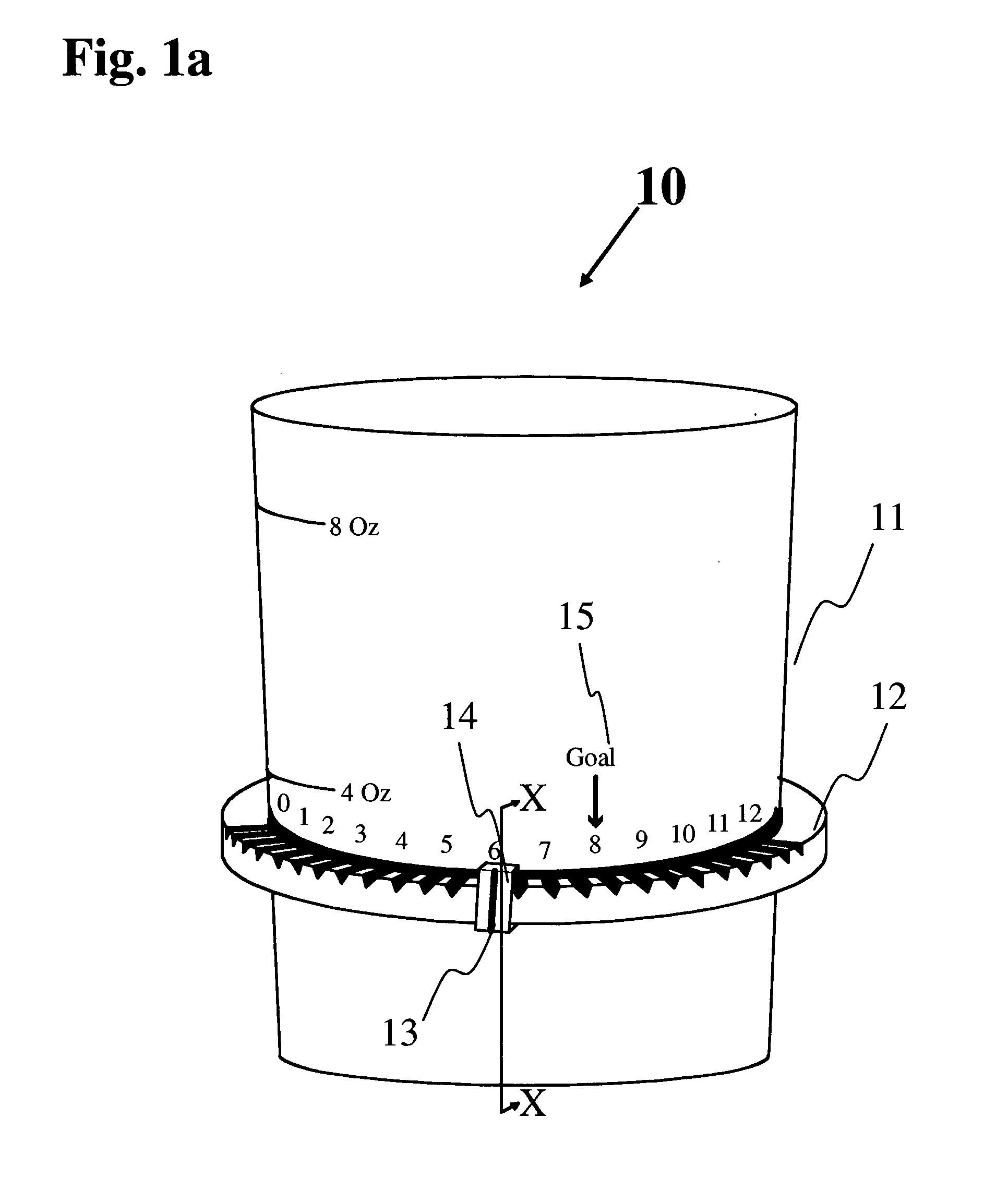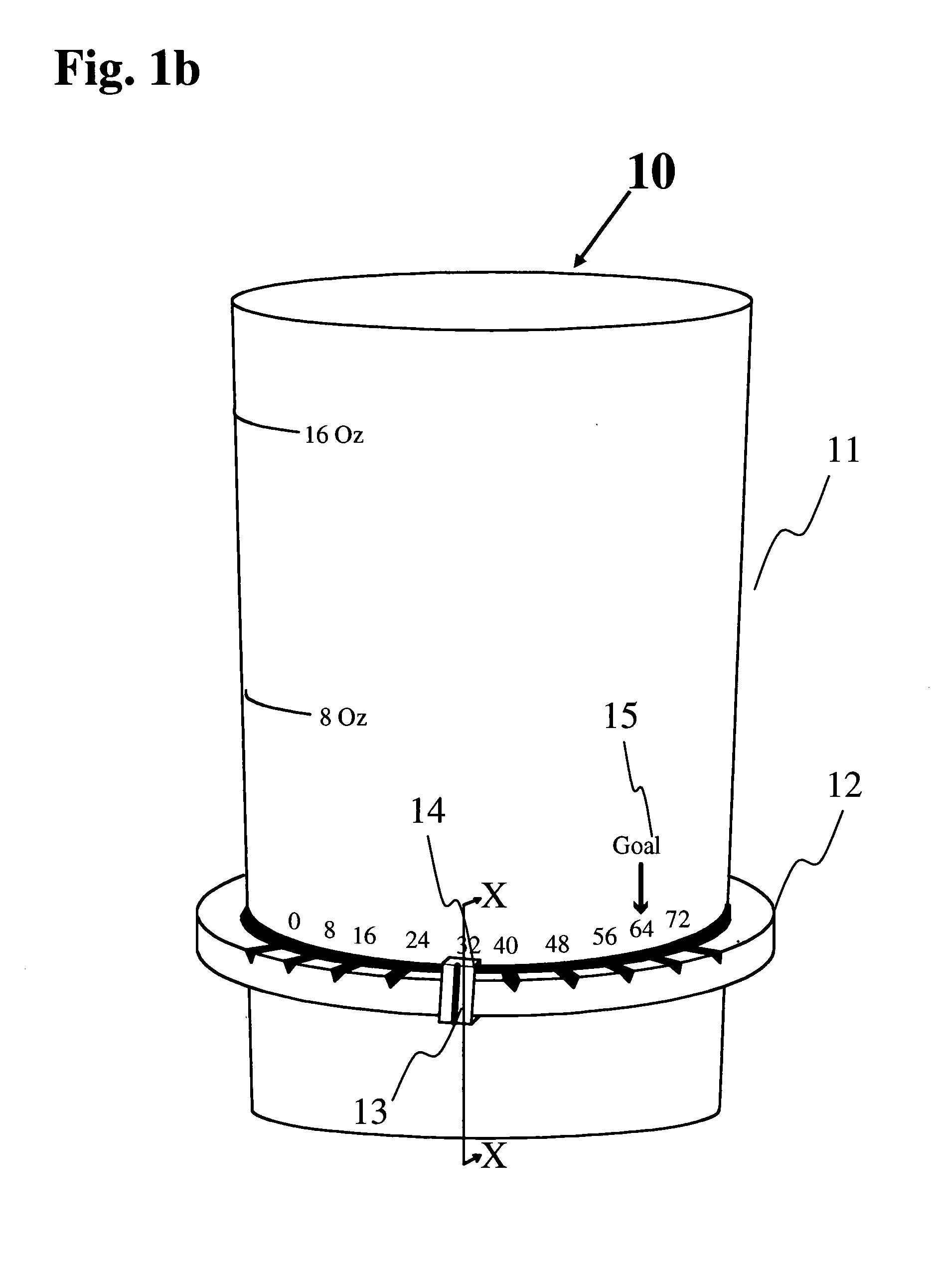[0015]The present invention provides a drinking vessel for dieters that allows the user to reliably and repeatedly keep track of the amount of water consumed during a 24-hour period. Advantageously, the drinking vessel is easily held and used without inadvertently altering the tracking mechanism. Tracking accuracy is reliably maintained over a prolonged period of time despite repeated cleaning with domestic or commercial dishwashers.
[0016]The vessel, preferably a glass or cup, has a liquid volume mark indicating 4 oz and 8 oz markers or, in a second embodiment, a larger glass with 8 oz and 16 oz markers. The glass is generally cylindrically shaped, preferably having a tapered sidewall for a comfortable
hand grasp during drinking of water. Each of these glasses has a base that is small enough to fit in a cup holder of a car or an SUV. A bottom portion of the cup has an integrally attached T cross section turned sideways ring attached to the sidewall, with the leg of the T contacting the sidewall. The location of the ring is sufficiently high that a drinking glass of either size can be readily secured in a cup holder of a car or an SUV. A detachable spring loaded U cross section rider that is turned sideways rides in this T cross section ring. The U shaped cross section is provided with two end projections, one on each side of the U. The space between the end projections is sufficient to clear the wide portion of the T cross section of the ring so that the rider may be inserted into the ring or removed from the ring at will. A series of V shaped notches on the top surface of the T cross section ring mate with a corresponding V shaped projection on the upper interior surface of the U cross section rider. The V shaped notches are positioned at equal distances apart and incrementally track the consumption of 4 ounce liquid amounts (approximately half of a full glass) consumed. The glass has indicia printed, raised, or embossed on its outer surface, representing the number of full glasses at full volume of liquid consumed. Such indicia bear labels 0, 1, - - - , 12, with each number being positioned over the corresponding V shaped notch. The drinking glass has a mark that clearly indicates a consumption goal of 8 cups, allowing the user to determine at a glance how many more cups must be consumed to reach the desired goal. Indicia designating full cup values are printed; and indicia designating half-cup values are left blank, to enhance
visibility. A user of the dieter's drinking glass keeps track of the liquid consumed by sliding the rider manually to the next notch as the water in the glass is consumed. Each glass has means for tracking water consumed to a precision of 4 ounces, or half a cup, using these notches.
[0019]A spring loaded rider with a pointer or an embossed or printed marker line is provided to ride smoothly on the T cross section ring and point to an indicia embossed or printed on the glass outer surface. A spring is provided on the bottom interior section of the U cross section rider, turned sideways. When the rider is inserted into the T section ring, the spring rests on the underside of the leg of the T cross section pushing the rider downwards. This permits the upper projection of the U cross section of the rider to enter behind the top of the T cross section of the ring, thereby preventing accidental removal of the rider from the T cross section ring. Moreover, the downward pushing action engages the V shaped projection of the rider with the V shaped notch of the ring, securing the rider at a user selected location. Advantageously, in use, the rider is held securely in place, and is not accidentally displaced, even by vigorous shaking of the drinking glass.
[0020]In order to move the rider to the next notch after consuming 4 ounces of water or moving the rider by two notches after consuming 8 ounces of water in the first embodiment, the user simply presses the rider upwards, using a finger or
thumb. This upward pushing action of the rider displaces the V shaped projection of the rider toward the upper surface of the ring, clearing the V shaped notch of the ring and allowing it to be moved freely. In this position, the rider can be readily removed from the T section ring, at which point the rider may be tilted away from the drinking glass and slid off to facilitate cleaning of the drinking glass. The rider may be reinserted by following an opposite sequence, wherein the bottom projection is inserted first behind the T cross section ring and the spring is compressed until the bottom of the upper projection of the rider slides over the upper surface of the T cross section ring. With this arrangement, the rider can be removed by the user at any time during the 24-hour period for cleaning of the drinking glass and reinserted back into any of the notches, so that the user does not have to lose track of water already consumed.
[0021]Generally stated, the invention comprises in one embodiment a drinking glass provided with 4 ounce and 8 ounce markers. In a second embodiment, a drinking glass is provided with 8 ounce and 16 ounce markers. In a third embodiment, a drinking glass is provided with 8 ounce, 16 ounce and 24 ounce markers. The glass is provided with an integral T cross section ring turned sideways, with the leg of the T non-rotationally attached to the outer surface of the drinking glass. A removable rider with a U cross section that is turned sideways is inserted over the T larger dimension and is displaced to the next one or two notches, as the case may be, when water is consumed in units of 4 ounce or 8 ounce in the first embodiment, or 8 ounce and 16 ounce in the second embodiment or 8 ounce, 16 ounce or 24 ounce in the third embodiment. The water consumed is tracked by a marker on the rider pointing to printed, raised or embossed indicia on the drinking glass. Accidental movement of the rider is prevented by engagement of a V shaped projection in the rider that mates with one of a plurality of V shaped notches present in the upper surface of the T cross section ring by spring tension from a spring that is attached to the bottom interior surface of the U shaped cross section of the rider.
 Login to View More
Login to View More  Login to View More
Login to View More 


